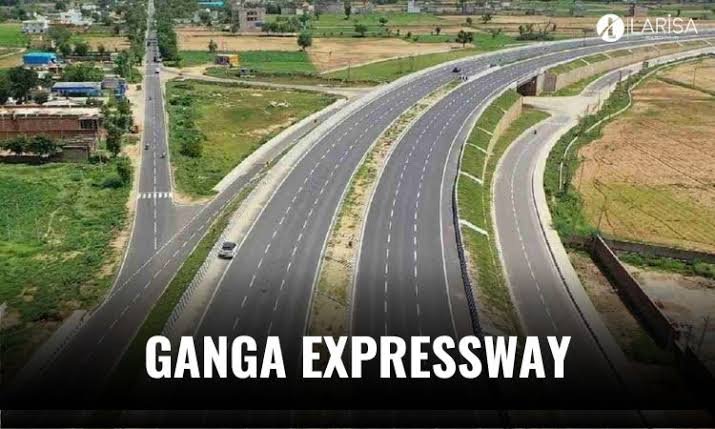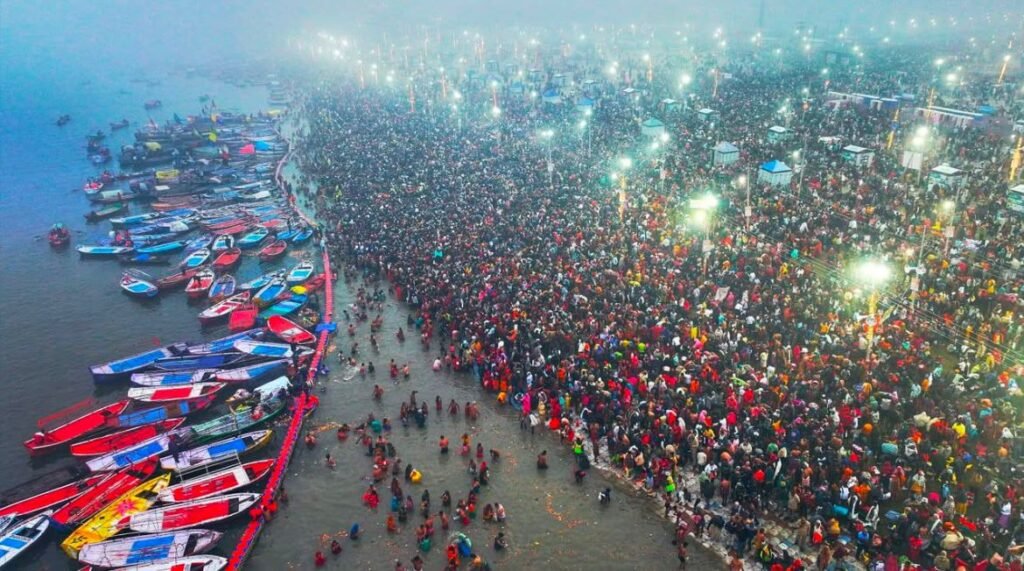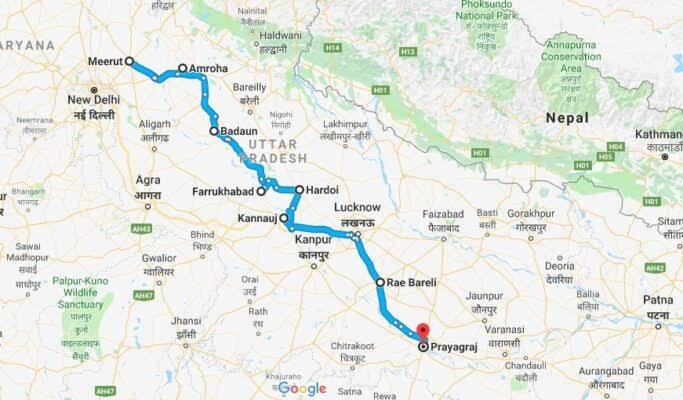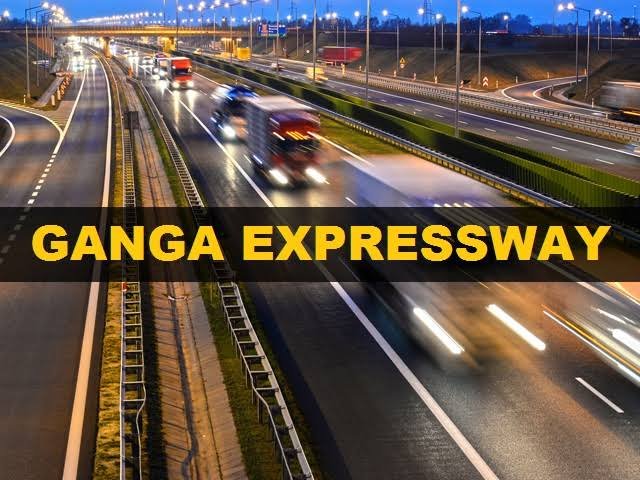With a six-hour commute from the western city of Meerut to the culturally vibrant city of Prayagraj, the Ganga Expressway is poised to revolutionize transport and connection in Uttar Pradesh. This massive 594-kilometer project is expected to connect eastern and western Uttar Pradesh, promoting economic development, improving cross-cultural interactions, and making travel easier for millions of people.

An Insightful Initiative
The Ganga Expressway demonstrates Uttar Pradesh’s dedication to contemporary infrastructure and is more than just a road. The expressway seeks to improve trade, shorten travel times, and connect far-flung areas by offering smooth connectivity. It serves as a lifeline for people in both western and eastern Uttar Pradesh, fostering closer ties to their communities and roots.
Connectivity and Route
In order to go to Prayagraj, the highway begins in Meerut and travels through important districts like Hapur, Bulandshahr, Amroha, Sambhal, Budaun, Shahjahanpur, Hardoi, Unnao, Rae Bareli, and Pratapgarh. It connects to numerous other highways and motorways along its path, forming an extensive network of connectivity that reaches to other states and important cities.
Impact on the Economy
It is anticipated that the freeway will transform regional trade and economy. The expressway is anticipated to boost commerce and investment by connecting important commercial centers, which will help local economies. For example, farmers now receive higher prices for their crop since it can travel more quickly to markets in Delhi and western Uttar Pradesh.
Due to better logistics and lower transportation costs, industries along the expressway’s length are also anticipated to grow. Better access to resources, markets, and skilled labor will help the region’s startups and small and medium-sized businesses (SMEs) innovate and develop. The expressway’s economic impact will be further enhanced by the creation of industrial centers and special economic zones, which will generate thousands of job opportunities for nearby communities.
Travel and Cultural Importance
Travelers and pilgrims will find it easier to visit thanks to the Ganga Expressway:
Prayagraj is well-known for the Kumbh Mela and the meeting point of the Saraswati, Yamuna, and Ganga rivers.
India’s spiritual capital, Varanasi, is well-known for its temples, ghats, and rich cultural legacy.
Mirzapur is renowned for its picturesque waterfalls and Vindhyachal Temple.

The road will increase tourism and assist local companies including hotels, restaurants, and handicrafts by reducing travel times. Cultural tourism projects and pilgrimage routes will flourish, making it easy for visitors to experience Uttar Pradesh’s rich history.
Environmental Aspects
The Ganga Expressway complies with environmental regulations thanks to the efforts of the Uttar Pradesh government. In order to reduce waterlogging, measures include installing cutting-edge drainage systems, using eco-friendly building materials, and planting trees along the route. The preservation of biodiversity in ecologically fragile places has received particular emphasis. The project’s dedication to sustainable development is demonstrated by the construction of wildlife corridors and underpasses to guarantee animals’ safe mobility.
Features of Safety
With its cutting-edge emergency response and surveillance technologies, the motorway guarantees its passengers a safe journey. Features consist of:
- CCTV Surveillance: Continuous observation to identify and address problems.
Rapid-response units are positioned along the route to provide ambulance services.
Emergency Call Boxes: Available to passengers in need on a regular basis.
In order to guarantee efficient traffic flow and prompt incident response, smart traffic management systems make use of AI and IoT technology.
Because of these safety-focused initiatives, passengers can trust the Ganga Expressway.
Connections to Other Freeways
The Ganga Expressway’s usefulness and reach are increased by its seamless integration with other important expressways:
The Farrukhabad Link Expressway is a 92-kilometer expansion of the Bundelkhand Expressway that connects Itawah and Hardoi.
Access to Barabanki, Amethi, Sultanpur, Ayodhya, Azamgarh, Mau, and Ghazipur is made possible via the Purvanchal Expressway.
Gorakhpur is connected to Ambedkar Nagar, Azamgarh, and Sant Kabir Nagar via the Gorakhpur Link Expressway.

Travelers may easily visit even the most isolated locations because to this integrated network, which fosters accessibility and regional growth.
Support for Regional Growth
It is anticipated that the Ganga Expressway will stimulate regional growth in Uttar Pradesh. Investments in healthcare, education, and infrastructure will flood into the districts along the path. It is anticipated that new residential complexes, logistics parks, and industrial zones would appear, changing the socioeconomic landscape of the area. Better connectivity will promote the construction of hospitals, colleges, and schools, improving the standard of living for locals.
Integration of Cultures
Through the highway, cultural integration would be promoted by linking Uttar Pradesh’s varied areas. The state’s cultural fabric will be enhanced by the new audiences for festivals, customs, and cuisines that are exclusive to the eastern and western regions. As it becomes easier to visit friends and family, this improved connectivity will likewise deepen social and familial ties. The highway acts as a bridge for shared experiences and cultural cohesion in addition to trade and travel.
Problems and Their Resolutions
Despite being a ground-breaking project, the Ganga Expressway has a number of difficulties:
Land Acquisition: Making certain that impacted landowners receive just compensation and relocation.
Reducing the impact of building on nearby ecosystems is known as the “environmental impact.”
- Funding and Maintenance: securing funding and guaranteeing the long-term viability of the motorway.
In order to satisfy project deadlines, logistical and administrative obstacles must be addressed.
In order to ensure seamless implementation and operation, the government has tackled these issues through open policies, stakeholder engagements, and public-private partnerships. To keep the project on course and handle any new problems, audits and progress reviews are carried out on a regular basis.
Prospective Growth
To further expand its reach, the second phase of the expressway will run from Prayagraj to Varanasi, Ghazipur, and Ballia. This phase’s surveys have already been completed, and building is anticipated to start shortly. The benefits of the project would be increased by this extension, which will offer smooth connectivity to eastern Uttar Pradesh and nearby Bihar. In order to create a seamless transportation network, plans are also in place to integrate the expressway with future infrastructure projects.
Residents’ Testimonials
Locals along the route have voiced hope for the expressway’s future:
Lokesh Thakur (Meerut): “It will now be easy to get to Prayagraj. I can travel to see my family more frequently and take advantage of new chances.”
Prayagraj’s Suman Mishra: “This expressway will bring our city closer to western Uttar Pradesh, opening doors for cultural exchanges and economic growth.”
Hardoi’s Ravi Kumar: “Our village won’t feel alone anymore. Our lives will be better and more developed thanks to the highway.
An Infrastructure Development Model
The Ganga Expressway establishes a standard for upcoming Indian infrastructure initiatives. Its focus on safety, sustainability, and socioeconomic advantages shows how significant advancements can have a good social influence. The highway is an example of effective and inclusive development since it incorporates cutting-edge technologies and follows international best practices.
Conclusion
The Ganga Expressway is a bridge that connects communities, opportunities, and aspirations; it is more than just a road. It promises to revolutionize Uttar Pradesh by cutting down on travel time, increasing trade, and improving connectivity.

As the project moves forward, it unites the state and clears the path for a better future, serving as a symbol of progress. The highway represents the idea of a contemporary, interconnected India where tradition and advancement coexist.







